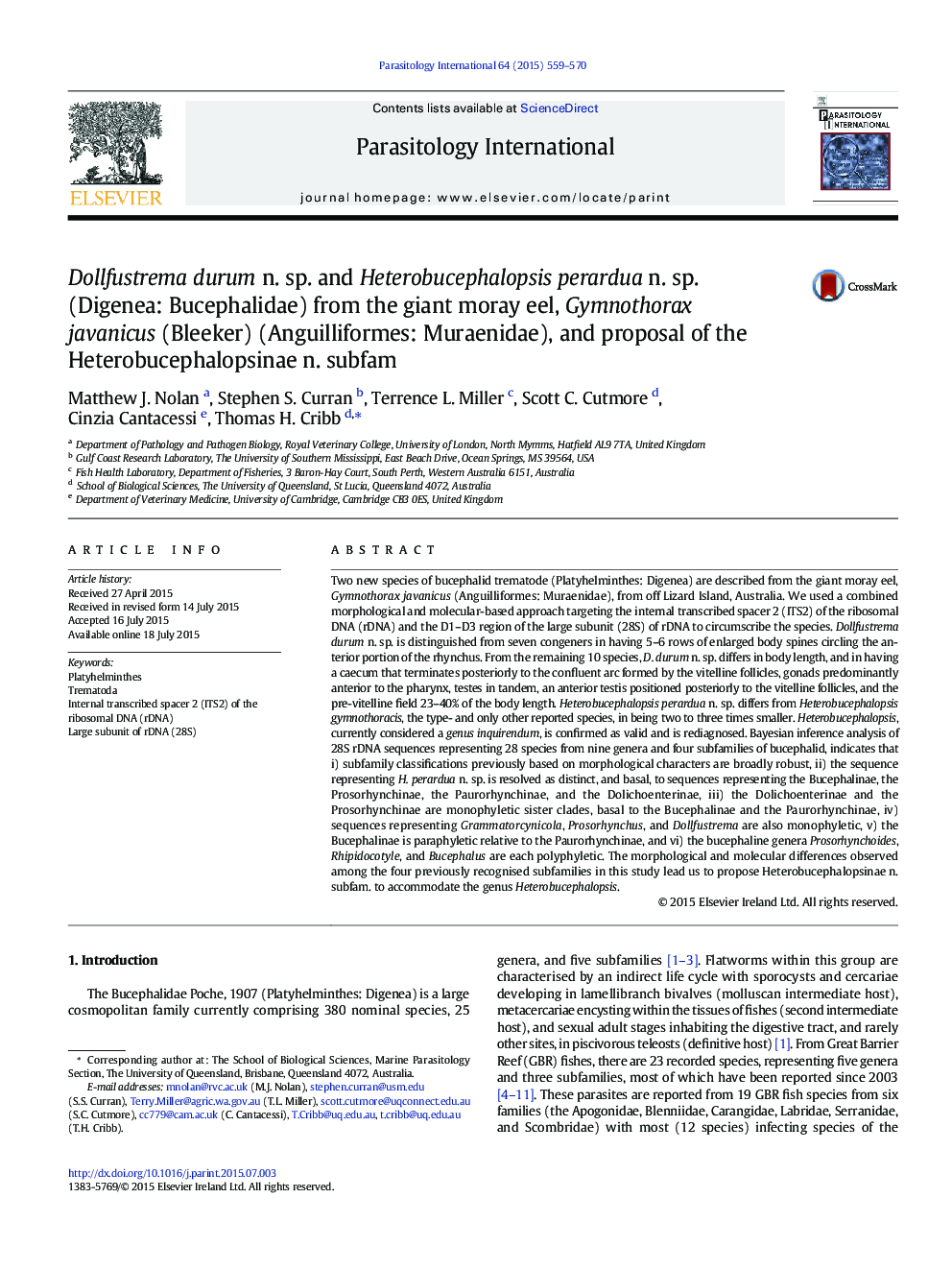| کد مقاله | کد نشریه | سال انتشار | مقاله انگلیسی | نسخه تمام متن |
|---|---|---|---|---|
| 3417777 | 1225471 | 2015 | 12 صفحه PDF | دانلود رایگان |

• Two species of bucephalid trematode are described from Gymnothorax javanicus.
• Heterobucephalopsis, currently considered a genus inquirendum, is confirmed as valid.
• Phylogenetic analysis of 28S indicates broadly robust subfamily classifications.
• The genera Prosorhynchoides, Rhipidocotyle, and Bucephalus are each polyphyletic.
• We propose Heterobucephalopsinae n. subfam. to accommodate Heterobucephalopsis.
Two new species of bucephalid trematode (Platyhelminthes: Digenea) are described from the giant moray eel, Gymnothorax javanicus (Anguilliformes: Muraenidae), from off Lizard Island, Australia. We used a combined morphological and molecular-based approach targeting the internal transcribed spacer 2 (ITS2) of the ribosomal DNA (rDNA) and the D1–D3 region of the large subunit (28S) of rDNA to circumscribe the species. Dollfustrema durum n. sp. is distinguished from seven congeners in having 5–6 rows of enlarged body spines circling the anterior portion of the rhynchus. From the remaining 10 species, D. durum n. sp. differs in body length, and in having a caecum that terminates posteriorly to the confluent arc formed by the vitelline follicles, gonads predominantly anterior to the pharynx, testes in tandem, an anterior testis positioned posteriorly to the vitelline follicles, and the pre-vitelline field 23–40% of the body length. Heterobucephalopsis perardua n. sp. differs from Heterobucephalopsis gymnothoracis, the type- and only other reported species, in being two to three times smaller. Heterobucephalopsis, currently considered a genus inquirendum, is confirmed as valid and is rediagnosed. Bayesian inference analysis of 28S rDNA sequences representing 28 species from nine genera and four subfamilies of bucephalid, indicates that i) subfamily classifications previously based on morphological characters are broadly robust, ii) the sequence representing H. perardua n. sp. is resolved as distinct, and basal, to sequences representing the Bucephalinae, the Prosorhynchinae, the Paurorhynchinae, and the Dolichoenterinae, iii) the Dolichoenterinae and the Prosorhynchinae are monophyletic sister clades, basal to the Bucephalinae and the Paurorhynchinae, iv) sequences representing Grammatorcynicola, Prosorhynchus, and Dollfustrema are also monophyletic, v) the Bucephalinae is paraphyletic relative to the Paurorhynchinae, and vi) the bucephaline genera Prosorhynchoides, Rhipidocotyle, and Bucephalus are each polyphyletic. The morphological and molecular differences observed among the four previously recognised subfamilies in this study lead us to propose Heterobucephalopsinae n. subfam. to accommodate the genus Heterobucephalopsis.
Figure optionsDownload as PowerPoint slide
Journal: Parasitology International - Volume 64, Issue 6, December 2015, Pages 559–570